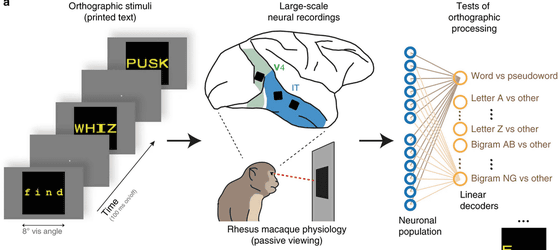Research results show that humans can read because they 'recycled areas of the brain that originally had different functions'

There are many aspects of human ability, such as reading and writing and manual dexterity, that distinguish us from other animals. Little is known. Neurologists at the Massachusetts Institute of Technology (MIT) show how the brain evolved areas specialized for reading within thousands of years after the reading and writing system was developed.
The inferior temporal cortex is a potential cortical precursor of orthographic processing in untrained monkeys |

Key brain region was 'recycled' as humans
developed the ability to read
https://medicalxpress.com/news/2020-08-key-brain-region-recycled-humans.html

Literacy adults have a visual cognitive ability called ' orthographic processing ' that allows them to efficiently read various fonts, sizes, and even broken handwriting. This is what creates the ability to read, and some scientists have proposed what they call the 'recycling hypothesis' for the area of the brain that is believed to be responsible for this ability. This suggests that parts of the visual system, such as those specialized for object recognition, have been repurposed for orthographic processing, an important component of reading, namely the ability to recognize letters and words. A study published in August 2020 by a research team in the Brain and Cognitive Sciences Division at MIT provided evidence to support this recycling hypothesis.
James DiCarlo, senior author of the paper, published in the journal Nature Communications, said: 'This study highlights a rapidly evolving understanding of the neural mechanisms of visual processing and an important primate behavior, namely humans. We have opened up a potential connection between the reading ability of

In the study, a method called functional magnetic resonance imaging (fMRI) studies identified an area called the visual word form area (VWFA) that functions when the brain processes written words. VWFA demonstrates the ability to extract words from a jumbled group of letters and recognize words from the connection of letters, but VWFA is a part of the visual cortex involved in object identificationInferotemporal scalp It seems that it was located in an area called the IT cortex.
According to Stanislas Dehaane, a professor of experimental cognitive psychology at
The researchers then displayed a flickering screen with written text in front of a macaque monkey , a type of cercopithecus, as shown in the image below, and input the monkey's neural activity patterns into a simple computer model. . According to the paper's lead author, Rishi Rajaringam, the monkeys aren't actually performing the task of predicting words from strings, but are 'stand-ins' where the model uses neural data to do the task. It is said to function as As a result, models derived from neural activity in animals perform approximately 70 orthographic processing tasks related to reading, such as distinguishing between words and nonwords and determining whether a particular letter is present in a string of words. Done with % accuracy.

In conclusion, the paper showed that the IT cortex is particularly well suited for repurposing for the skills required for reading, suggesting that 'some of the reading mechanisms are constructed by reusing object recognition mechanisms.' Researchers say that they can support the hypothesis that it is done.
According to this research, it seems that reading and writing do not add new functions to the brain, but replace some of the functions originally provided in the brain. This suggests that tasks related to reading ability, such as distinguishing meaningless words from meaningful words and extracting specific letters from words, are possible even in non-human primates who do not know how to read. was suggested. In fact, in a 2012 study published in the journal Science, French cognitive psychologists showed that baboons can learn to distinguish between words and non-words.
Researchers are also conducting research to train animals to perform tasks such as word discrimination and measure how neural activity changes.
Related Posts:
in Science, Posted by log1e_dh







